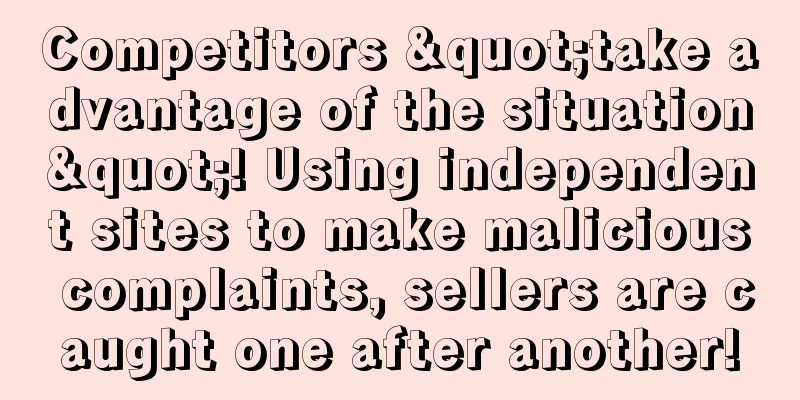The problem of restricted storage capacity has been snowballing in recent times. In order to save the "half-dead" sales volume, sellers have started to adopt the strategy of small profits but quick turnover, and the price war among peers has become increasingly fierce.
As profits plunged, the bad news of the exchange rate fall once again dealt a heavy blow to sellers. As of today, the onshore and offshore RMB exchange rates against the US dollar were 6.3938 and 6.3866 respectively , squeezing the already dry profit sponge of sellers. However, under the multiple pressures of internal and external troubles, sellers not only have to fight against Amazon and the external environment, but also have to be vigilant against their peers who take advantage of the situation. The peers are despicable and use independent sites to complain about infringement Recently, a seller reported that the ASINs they were selling were maliciously complained by competitors one after another. It is reported that the competitors first used independent websites to complain about the seller's products, and then sued the seller for trademark infringement . Under this series of bad tactics, the seller's products have been reported and removed from the shelves, and the specific infringement content has not been found so far. ▲ The picture comes from Zhiwubuyan
Amazon stated in the penalty email that the seller’s ASIN was banned because it received a complaint about trademark infringement. However, the letter did not specify the specific content of the infringement, so the seller was hesitant between directly appealing the misjudgment and admitting the mistake. ▲ The picture comes from Zhiwubuyan
In response to this, some sellers pointed out that the seller's email did not disclose the full information. Amazon's notification emails usually contain the trademark registration number and complainant information. Based on this information, it is possible to check whether there are any words involving infringement in the title, five points, details page, etc. ▲ The picture comes from Zhiwubuyan
However, the seller said that after checking all the files in his mailbox, he confirmed that he had only received this complaint notice, and that all the content was published. He also did not find any infringing words when checking the listing in the background, and he had no idea what means the opponent used to label his listing with infringing words. In response to the seller's situation, some sellers made the following suggestions: 1. Confirm which site is being copied and adding relevant sensitive words in the listing. If the product is listed on the US site, it may be copied and sold by competitors on the Canadian and Mexican sites and the listing has been changed. You need to open a case at the Canadian and Mexican sites and ask customer service to help confirm whether there are relevant sensitive words. 2. After confirming which site it is, use the inventory loading tool on the corresponding site to delete the listing, and then use the original SKU and ASIN to upload and refresh using the table template. In this way, sensitive words will be removed. 3. Just in case, go back to the site where the product was listed and use the method in the second point to delete the listing and then re-list it with the same SKU and ASIN. Then open a case and ask customer service to refresh and restore the listing. ▲ The picture comes from Zhiwubuyan Sellers are repeatedly targeted. How should they respond to malicious complaints? Coincidentally, many sellers have recently encountered competitors using independent websites to complain about product infringement. According to a seller, the competitor uploaded his product to the independent website intact and then turned the tables, reporting that the seller's product was suspected of infringement, causing his product to be removed from Amazon.
▲ The picture comes from Zhiwubuyan
It is reported that the seller has been operating in this category longer than his competitors. However, after the products were put on the shelves, the competitors added sensitive words on the Canadian and Mexican sites, causing the seller's similar products to be banned from sale. The seller spent a lot of time to successfully appeal and resume sales, but within two days the page was deleted again. Amazon emailed him that it was due to an infringement complaint from an independent website . The seller searched for the independent website and found through various clues that it was a competitor's website. Looking at the experiences of the above sellers, we can see that as the potential of the blue ocean of cross-border trade is gradually tapped, more and more sellers are competing to enter the market, accelerating the industry's involution. Under such circumstances, many people choose to take shortcuts and use inferior competition methods to attack their peers. Faced with malicious competition methods such as complaints of infringement, it is difficult for sellers to completely eliminate them. For sellers, when responding to malicious complaints of infringement, they must pay attention to the following points: 1. Be sincere and express your willingness to cooperate with the investigation and analyze the reasons why the listing was blocked. 2. Provide Amazon with relevant evidence such as invoices, authorizations, and patent certificates. 3. Contact the brand and provide proof that the brand clearly states that the email address complained about does not belong to them. 4. Develop effective improvement plans, make your attitude clear, and ensure that similar incidents will not occur in the future. Amazon is now cracking down more and more, and malicious attacks from competitors are hard to guard against. Recently, there is even a distorted trend of excessive price cuts. Sellers are deeply trapped in it and feel that they are "attacked from all sides". How can they relieve their worries? The only thing they can do is to hope that they can stage a Jedi counterattack on the upcoming Prime Day.
|










